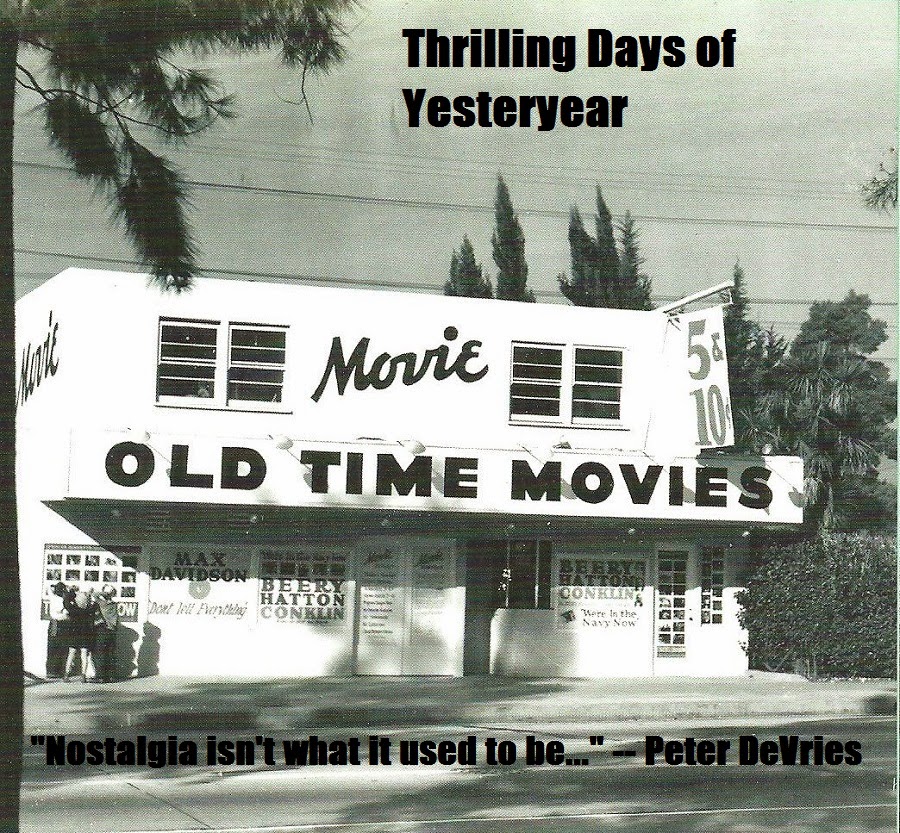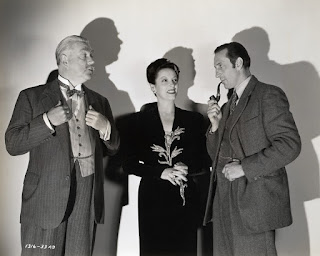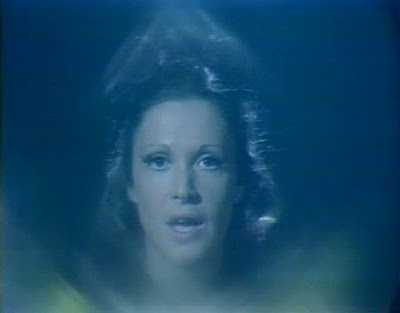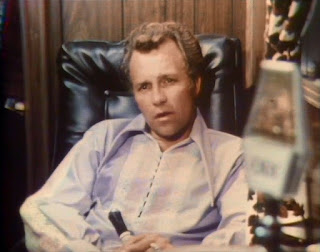The following essay is Thrilling Days of Yesteryear’s contribution to The Universal Pictures Blogathon, currently being observed from October 29-31 and sponsored by
If you were making a living as a silver screen detective in the days of classic Hollywood…chances are that unless you were Nick or Nora Charles (MGM’s “Thin Man” couple) you were pretty much pounding a beat in the B-picture side of Celluloid City. Just about every studio had a second feature gumshoe—Columbia pretty much cornered the market on them, with the likes of Boston Blackie, The Lone Wolf, Ellery Queen, etc.—but Universal Pictures, save for their “Crime Club” pictures in the 1930s, seemed to be the last out of the starting gate. This was subject to change in 1942, when the studio inked a $300,000 deal with the Sir Arthur Conan Doyle estate for the film rights to the Greatest Detective of All Time—Sherlock Holmes of 221-B Baker Street.
Sherlock Holmes was not only the subject of the cinema’s
first recorded detective film (Sherlock
Holmes Baffled, a thirty-second feature released in 1900), he’s also the
most recurring sleuth to appear on the big screen (over 200 films since Baffled’s initial release—played by
over 70 actors). Universal’s Holmes
series originated with a pair of features released by 20th Century-Fox in 1939:
The Hound of the Baskervilles and The Adventures of Sherlock Holmes. These two films, starring Basil Rathbone as
Holmes with Nigel Bruce as Watson, were tremendously successful at the box
office—so much so that Fox tried to negotiate with the Conan Doyle estate a contractual
continuation with the characters, with the idea being that one Holmes picture
would be made and released per year. But
the estate insisted that the studio’s scripts remain faithful to the original
stories (instead of inventing new ones), and negotiations broke down not long afterward.
In light of the direction the series moved towards at
Universal in later years, it’s a wonder that the studio and the Doyle people came
to any sort of agreement at all. But the
300 K that Universal ponied up to make more Holmes pictures included the rights
to 21 of Sir Arthur’s short stories, several of which provided the grist for
the Universal Holmes releases. To add a
cherry to this hot fudge sundae, Messrs. Rathbone and Bruce were persuaded to
reprise their roles in the new venture; Basil and Nigel had been playing the
parts on radio since 1939, on a NBC/Blue program sponsored by Bromo Quinine (they’d
get a new sponsor in Petri Wines—along with a new network, Mutual—in the fall
of 1943).
The first of the twelve Universal Holmes ventures was
released on September 18, 1942: Sherlock
Holmes and the Voice of Terror. A
title card at the beginning of the film reads thusly:
Sherlock Holmes, the
immortal character of fiction created by Sir Arthur Conan Doyle, is ageless,
invincible and unchanging.
In solving significant
problems of the present day he remains – as ever – the supreme master of
deductive reasoning.
By “significant problems of the present day” Universal meant
only one thing: N-A-Z-I-S. That’s right,
cartooners—Sherlock Holmes had been enlisted to fight for the Allied
cause! This updating of the great
detective’s environs from the late Victorian era to the twentieth century elicited
a lot of howls from the dedicated disciples of the Conan Doyle “canon”…but when
you stop and think that the story Voice
of Terror is based on—“His Last Bow,” the first of the Conan Doyle stories
to be adapted as part of the studio’s deal with the estate—it’s really not all
that sacrilegious. “Bow” brings Holmes
out of retirement (beekeeping, you know) in 1917 to nab a German spy during the
First World War…so is it really that much of a stretch to have him dealing with
the Hun again twenty-five years later?
The real slap-in-the-face to canon devotees was the development onscreen
of the Dr. John H. Watson character, who was presented in the Holmes stories
and novels as a thoughtful, levelheaded, and capable sort. In the hands of character great Nigel Bruce—and
to be fair, this practice started in the 20th Century-Fox films as a way to
provide contrast between the two men—he was transformed into a buffoonish fool who
functioned as each film’s comic relief.
My mother, a dedicated “Baker Street Irregular,” knows full well that
the Watson of the movies is nothing at all like Conan Doyle’s creation…and yet
she was always perfectly okay with it. “Look
at it this way,” she once remarked, “when you’re standing next to a guy who’s
as brilliant as Sherlock Holmes…doesn’t it stand to reason that you’re going to
come across as the person who rode the short bus to school?”
Voice of Terror
is an entertaining entry in the Universal Holmes series—the only one to be
directed by John Rawlins, whose admittedly undistinguished career was relegated
to programmers, serials (The Green
Hornet Strikes Again!, Overland Mail)
and later TV series like Mayor of the Town (which originally
started out on radio). It also served as
the film debut of character actor Thomas Gomez, who’s a particularly nasty
piece of work as a foreign agent tangling with our heroes. With the second entry, Sherlock Holmes and the Secret Weapon (1943), the series would be handled
by Roy William Neill (Black Moon, The Black Room)—a B-picture veteran particularly
adept at making the admittedly low-budget Holmes films look like stylish “A”
efforts. (Neill would later take over producer
chores on the Sherlock Holmes series as well.)
Secret Weapon is
my particular favorite of the “wartime” Holmes; it’s able to borrow elements
from a Conan Doyle tale (“The Adventure of the Dancing Men”) to present a
first-rate suspenser of Holmes’ attempts to keep an inventor (William Post,
Jr.) from falling into the clutches of the Nazis. Instead, the scientist is captured by
Sherlock’s nemesis, Professor Moriarty (Lionel Atwill)—who apparently has no
loyalty to his home country as far as the war’s concerned. In the Rathbone-Bruce films, Moriarty turns
up three times: he’s played by Atwill in Secret
Weapon, previously by George Zucco in Fox’s The Adventures of Sherlock Holmes, and by the great Henry Daniell
in the later The Woman in Green (1945). I enjoy all three portrayals immensely, but I
give Lionel the edge only because he has that wonderful response to Holmes’
detailed explanation of how he would do away with his arch enemy (he would rig
up an apparatus that would slowly drain Moriarty’s blood): “The needle to the
last…eh, Holmes?” (The Great Detective’s
cocaine addiction is only hinted at in this film and at the end of Baskervilles: “Oh, Watson…the needle!”)
Secret Weapon
also marked the first appearance of actor Dennis Hoey as Holmes’ Scotland Yard
contact, Inspector Lestrade. Once again,
liberties were taken with how Lestrade was originally portrayed in the Conan
Doyle canon (where he was actually a bright, ambitious detective—and quite
adept at office “politics” as well); in the Universal movies, Lestrade’s
intellect was on a par with Watson’s.
But Hoey was a wonderful addition to the movies (“That’s right, Mr.
Holmes—and it’s no good sayin’ it ain’t!”) and when he’s not around (he appears
in half of the films) he’s a missed presence.
The third of the Holmes “haircut” films—I call them this
because of that risible swept-from-the-sides hair style Rathbone sports in the
first three vehicles—is Sherlock Holmes
in Washington (1943), an entry that induces the Baker Street duo to travel
across the pond in search of a courier (Gerald Hamer) who has a microfilmed
document of “great international importance” on his person. (How’s that for a MacGuffin?) I find Washington
to be one of the weaker Universal Holmes pictures…which is kind of odd, because
it has some interesting set pieces and sequences (Watson’s fascination with
chewing gum, the microfilm that’s passed back-and-forth between the characters
because they’re unaware it’s concealed in a matchbook) and features two of the “Moriartys”
as villains: Zucco and Daniell. (TDOY fave Clarence Muse also has a
sizeable role as a train barman—it’s a thankless part, to be sure, but Muse
works wonders with it.) But honest to my
grandma: the last time I watched this one (some birthday largess from sister
Debbie allowed me to purchase all of the Rathbone-Bruce Holmes flicks on
Blu-ray) I slept through the last half.
(My mother did, too—but that’s normal with her.)
Even though the next entry in Universal’s Sherlock Holmes
series, Sherlock Holmes Faces Death
(1943), eliminated the need for the Great Detective to function as an agent on
behalf of the Allies, it and a few films to follow still reminded audiences—in case
it slipped their collective minds—that there was a war on. But apart from the background of an ancestral
home being used as a place of convalescence for British military officers (that’s
why Watson’s on the scene; he’s an advising physician) Death returns to the familiar trappings of the Holmes stories by
presenting a good old-fashioned murder mystery.
(The Holmes films would function in a kind of quasi-Victorian universe
with this and subsequent features.) It’s
loosely based on Conan Doyle’s “The Musgrave Ritual,” with Holmes and Watson
investigating the deaths of a family who adhere to the titular duty. Death
is another Universal Holmes I particular enjoy; its rather drab denouement
doesn’t detract from the fine performances from the series’ regulars (including
Mary Gordon as Mrs. Hudson—Gordon was also a carryover from the Fox films) and
featured players like Hillary Brooke and Milburn Stone…plus a creepy Gothic
atmosphere that makes good use of some old Frankenstein
and Dracula sets.
1944 was a banner year as far as the Universal Sherlock
Holmes movie series was concerned.
Things kicked off with The Spider
Woman (1944), my second favorite of the Universal Holmes films…and the
reason for this can be summed up in two words: Gale Sondergaard. Sondergaard
(as Adrea Spedding) is a super-villainess who proves to be a formidable
opponent for our hero: she is the mastermind behind a series of “pajama
suicides” that are running rampant through London. There’s an undeniably “high camp” element to Spider Woman—it plays at times like a
condensed cliffhanger serial—but a more enjoyable entry in the Universal Holmes
vehicles will be difficult to find.
(There are overtones of Conan Doyle’s “The Adventures of the Dying
Detective”—in which Holmes feigns a fatal illness to solve a case—and Spedding
herself suggests “The Woman”: Irene Adler, the antagonist in “A Scandal in Bohemia.”) There’s a nod to the war in the climactic
scene where Watson and Lestrade take aim at caricatures of Tojo, Mussolini and
Hitler at a carnival’s shooting gallery…unaware that Holmes is bound and gagged
behind one of them.
Next to follow was The
Scarlet Claw (1944)—for many fans the high point of the series. While I do like the film, I’m not as
enraptured as others because I find the plot a bit unexceptional (once you
learn the identity of the killer, you’re hard pressed to want to watch it again
like some of the other Holmes movies).
What elevates Claw to the
position it enjoys is the first-rate direction by Neill, who harkens back to
his earlier work on Frankenstein Meets
the Wolf Man (1943) to create a dandy, atmospheric entry that works as both
mystery and horror film. (The
fog-shrouded Canadian marshlands also suggest the moors from The Hound of the Baskervilles—truly, Neill
knew the cardinal rule of making B-pictures: “Fog is your best friend.”)
My choice for the best of the Universal Holmes movies—and even
if you disagree, it still remains my favorite of the bunch—is the final film
released in 1944, The Pearl of Death. Like Claw,
it’s both mystery and horror movie: Holmes is on the trail of a priceless pearl
that’s been squirreled away in one of six busts of Napoleon (the movie reworks
Conan Doyle’s “The Adventure of the Six Napoleons”)…but he also runs afoul of a
homicidal maniac known as “The Hoxton Creeper.”
Pearl of Death wasn’t horror
icon Rondo Hatton’s first movie but it’s unquestionably the one that put him on
the map; before his untimely death in 1946 from acromegaly he would play “Creeper”-like
characters in such films as House of
Horrors and The Brute Man, both
released after his death.
Pearl also
features a pair of challenging villains in Giles Conover (Miles Mander) and his
female accomplice Naomi Drake (Evelyn Ankers, in a nice change-of-pace from her
usual “Scream Queen” roles); Conover gains possession of the titular gem by
capitalizing on Holmes’ arrogance (Lestrade’s delight at Sherlock’s cock-up is
worth the price of admission), and it’s fun to watch him, Holmes and Naomi
consistently top one another in the disguises department. Also, there’s a delicious irony in that
Mander’s Conover dies at the hand of The Creeper…and then later that same year
is killed in Murder, My Sweet (1944)
in a manner that some say inspired the Creeper killings in Pearl (Moose Malloy was known to snap a spine or two).
It wasn’t necessarily downhill for Universal’s Holmes series
after The Pearl of Death—but the
entries that followed were some of the most anemic, demonstrating that the
successful formula was starting to run out of gas. The
House of Fear (1945) is another vehicle in which once you’ve sussed out the
guilty party (the movie was adapted from Conan Doyle’s “The Five Orange Pips”)
there’s really no need to revisit it (I could watch Pearl of Death a million times and never get tired of it). It does feature an endearingly eccentric
performance from character actor Aubrey Mather, as well as nice turns from
Holmes series stand-bys Paul Cavanaugh, Holmes Herbert and Gavin Muir. The
Woman in Green (1945) spotlights the full-on villainy of Henry Daniell as
Moriarty (with Hillary Brooke as his partner-in-crime), which a number of fans
consider the best Moriarty portrayal of the Rathbone-Bruce features.
But then you have Pursuit
to Algiers (1945)—believed by most to be the lowest point in the
franchise. A promising start soon turns
into a death spiral of boredom as Holmes and Watson are essentially hired to be
bodyguards for a foreign monarch while matching wits with the most tedious
aggregation of villains in the history of Universal’s series (they’re so
colorless they’re rounded up off-camera).
(I tried to re-watch this one before I wrote this for the blogathon…and
I was in the arms of Morpheus before the damn thing ended.) Terror
by Night (1946) is a bit of an improvement—it’s Dennis-Hoey-as-Lestrade’s
swan song, and he’s allowed the rare moment of lucidity in helping Holmes
defeat a would-be jewel thief—but situating the story against the background of
a moving train does little to alleviate the sluggish pace of the film (even if it is only an hour long).
By 1946, Basil Rathbone had had enough of playing Sherlock
Holmes. He had become so identified with
the character that he purportedly lost out to favorite silver screen cad George
Sanders for the role of Lord Henry Wotton in MGM’s The Picture of Dorian Gray (1945).
Dressed to Kill (1946) would
be the final entry in the Rathbone-Bruce Holmes ledger, and though it’s not
particularly held in high regard by a lot of people (I do agree that title is pretty lame) I have to confess a special
fondness for it. The story—a search for
missing bank plates whose location is concealed in the notes of several music
boxes—is sort of a pastiche of past Sherlock Holmes features, with elements of Pearl of Death, Secret Weapon and Scarlet
Claw cribbed to fashion what would be the detective’s curtain call. (The major asset of Dressed is a sensational performance
from Patricia Morison—“the poor man’s Gale Sondergaard”—in a role not unlike Spider Woman’s Adrea Spedding.)
With the release of Dressed to Kill, Basil Rathbone bid
The Great Detective a not-so-fond fare-thee-well and returned to the stage (and
scored a hit in The Heiress, winning
a Tony Award for his work); his partner, Nigel Bruce, actually soldiered on a
bit longer in the role of Watson on radio’s The New Adventures of Sherlock
Holmes (hey—he got a big honkin’ raise and top billing…who wouldn’t
stick around for that?) for the 1946-47 season, playing sidekick to Tom Conway’s
Holmes. But tension between the show’s
writers and producer made the experience an unhappy one for “Willy” and he
relinquished the part to continue appearing in character roles in films until
his death in 1953.
As for the man who’s perhaps best associated as the
consulting detective from 221-B Baker Street, Basil Rathbone would play Holmes
on only one other occasion: in a 1953 play (written by his wife Ouida) that had
the ignominy to open and close on the same night. Rathbone would return to films (I
particularly enjoy his comic villainy in Casanova’s
Big Night and The Court Jester),
and the Sherlock Holmes franchise would continue to win over audiences with
reissues courtesy of Realart. Somewhere
along the way, however, Universal sold the Holmes movies for some quick cash…and
its subsequent custodians did not take as good care of them as they should
have. When the Rathbone-Bruce Holmes movies
were released to DVD by MPI Home Video in 2006, many of them were UCLA Film and
Television Archive restorations funded by none other than Mr. Hugh Hefner
himself. (Think about that the next time
you crack an “I only read it for the articles” joke.)







































